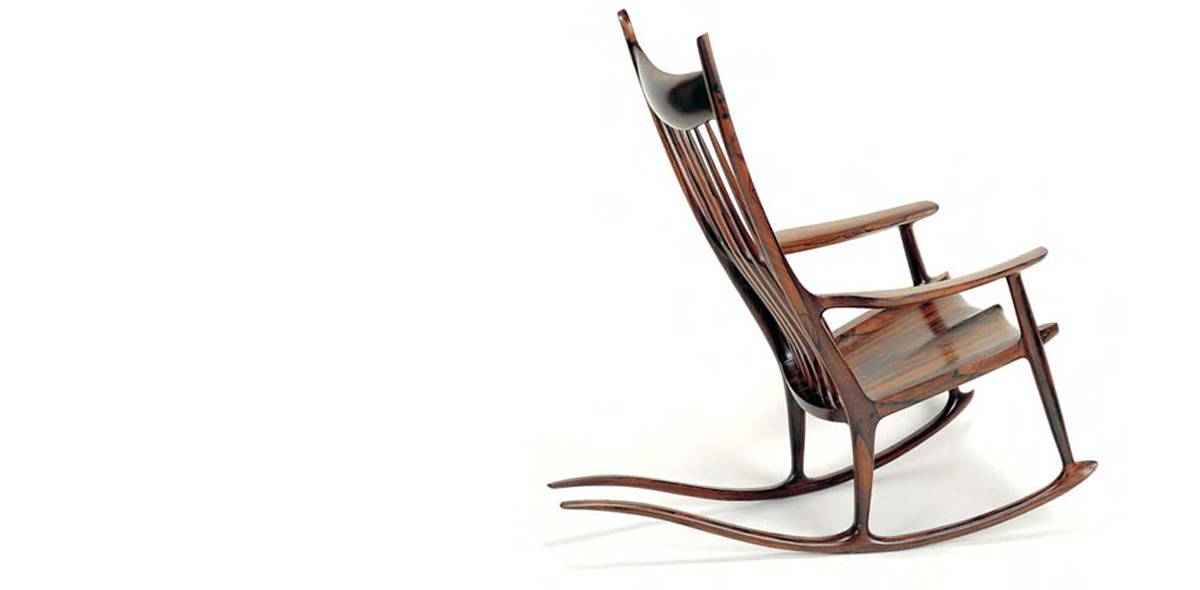The Rocking Chair of Sam Maloof –– Furniture with Spirit
The legendary carpenter transformed a chair into a link with the very essence of the human spirit.
“There’s a lot of work being done today that doesn’t have any soul in it. The technique may be the utmost perfection, yet it is lifeless. It doesn’t have a soul. I hope my furniture has a soul to it,” remarked the legendary carpenter, Sam Maloof.
There’s something in him, in his way of working, reminiscent of traditional Japanese carpentry, in which part of a cobra tree gains a second life when converted to furniture. Entirely self-taught, Maloof created some of the most beautiful and sturdiest furniture in history, and though all have the quality of sculpture, he was never an artist but a carpenter. He was a worker who considered his hands as a medium between the mortal and the divine.

One of his rocking chairs, donated to the Smithsonian American Art Museum in 1997, displays the ideal balance of beauty and utility. “Art in the service of utility” is the essence of Maloof’s philosophy of design. If the chair is already that most “human” of furnishings, one that exists precisely because it reproduces the form of the seated person, the rocking chair has it more so, the grace of rhythm, and a repetitive melody. Hypnotic, it links the human with magic. No wonder rocking chairs have been the favorite setting for the feeding and lulling of babies, and for watching afternoons pass. There’s something quite literally charming in the maritime movement of that particular piece of furniture. Designs by Sam Maloof, when they appeared in the late 1940s, were quickly commissioned because their shape simply emanated beauty.
Maloof handcrafted each of his more than 5,000 furniture pieces at his workshop in California. “I want to be able to work a piece of wood into an object that contributes something beautiful and useful to everyday life. And I want to do this for an individual that I can come to know as a friend,” he said once as if penning the manifesto that he always held to the letter. He was a simple carpenter who made history because the chairs he made were alive; they had spirit.
Images courtesy of SAAM.
Related Articles
Pictorial spiritism (a woman's drawings guided by a spirit)
There are numerous examples in the history of self-taught artists which suggest an interrogation of that which we take for granted within the universe of art. Such was the case with figures like
Astounding fairytale illustrations from Japan
Fairy tales tribal stories— are more than childish tales. Such fictions, the characters of which inhabit our earliest memories, aren’t just literary works with an aesthetic and pleasant purpose. They
A cinematic poem and an ode to water: its rhythms, shapes and textures
Here lies One Whose Name was writ in Water. - John Keats Without water the equation of life, at least life as we know it, would be impossible. A growing hypothesis holds that water, including the
Watch beauty unfold through science in this "ode to a flower" (video)
The study of the microscopic is one of the richest, most aesthetic methods of understanding the world. Lucky is the scientist who, upon seeing something beautiful, is able to see all of the tiny
To invent those we love or to see them as they are? Love in two of the movies' favorite scenes
So much has been said already, of “love” that it’s difficult to add anything, much less something new. It’s possible, though, perhaps because even if you try to pass through the sieve of all our
This app allows you to find and preserve ancient typographies
Most people, even those who are far removed from the world of design, are familiar with some type of typography and its ability to transform any text, help out dyslexics or stretch an eight page paper
The secrets of the mind-body connection
For decades medical research has recognized the existence of the placebo effect — in which the assumption that a medication will help produces actual physical improvements. In addition to this, a
The sea as infinite laboratory
Much of our thinking on the shape of the world and the universe derives from the way scientists and artists have approached these topics over time. Our fascination with the mysteries of the
Sharing and collaborating - natural movements of the creative being
We might sometimes think that artistic or creative activity is, in essence, individualistic. The Genesis of Judeo-Christian tradition portrays a God whose decision to create the world is as vehement
John Malkovich becomes David Lynch (and other characters)
John Malkovich and David Lynch are, respectively, the actor and film director who’ve implicitly or explicitly addressed the issues of identity and its porous barriers through numerous projects. Now










